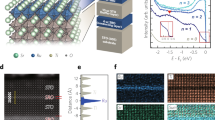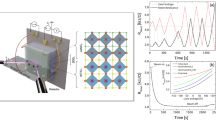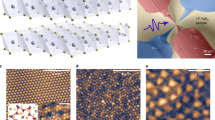Abstract
Many-body interactions in transition-metal oxides give rise to a wide range of functional properties, such as high-temperature superconductivity1, colossal magnetoresistance2 or multiferroicity 3. The seminal recent discovery of a two-dimensional electron gas (2DEG) at the interface of the insulating oxides LaAlO3 and SrTiO3 (ref. 4) represents an important milestone towards exploiting such properties in all-oxide devices5. This conducting interface shows a number of appealing properties, including a high electron mobility4,6, superconductivity7 and large magnetoresistance8, and can be patterned on the few-nanometre length scale. However, the microscopic origin of the interface 2DEG is poorly understood. Here, we show that a similar 2DEG, with an electron density as large as 8×1013 cm−2, can be formed at the bare SrTiO3 surface. Furthermore, we find that the 2DEG density can be controlled through exposure of the surface to intense ultraviolet light. Subsequent angle-resolved photoemission spectroscopy measurements reveal an unusual coexistence of a light quasiparticle mass and signatures of strong many-body interactions.
This is a preview of subscription content, access via your institution
Access options
Subscribe to this journal
Receive 12 print issues and online access
$259.00 per year
only $21.58 per issue
Buy this article
- Purchase on Springer Link
- Instant access to full article PDF
Prices may be subject to local taxes which are calculated during checkout




Similar content being viewed by others
References
Bednorz, J. G. & Muller, K. A. Perovskite-type oxides: The new approach to high-Tc superconductivity. Rev. Mod. Phys. 60, 585–600 (1988).
Von Helmolt, R. et al. Giant negative magnetoresistance in perovskitelike La2/3Ba1/3MnOx ferromagnetic films. Phys. Rev. Lett. 71, 2331–2333 (1993).
Kimura, T. et al. Magnetic control of ferroelectric polarization. Nature 426, 55–58 (2003).
Ohtomo, A. & Hwang, H.. A high-mobility electron gas at the LaAlO3/SrTiO3 heterointerface. Nature 427, 423–426 (2004).
Takagi, H. & Hwang, H. Y. An emergent change of phase for electronics. Science 327, 1601–1602 (2010).
Thiel, S. et al. Tunable quasi-two-dimensional electron gases in oxide heterostructures. Science 313, 1942–1945 (2006).
Reyren, N. et al. Superconducting interfaces between insulating oxides. Science 317, 1196–1199 (2007).
Brinkman, A. et al. Magnetic effects at the interface between non-magnetic oxides. Nature Mater. 6, 493–496 (2007).
Cen, C. et al. Nanoscale control of an interfacial metal–insulator transition at room temperature. Nature Mater. 7, 298–302 (2008).
Mannhart, J. & Scholm, D. G. Oxide interfaces—an opportunity for electronics. Science 327, 1607–1611 (2010).
Siemons, W. et al. Origin of charge density at LaAlO3 on SrTiO3 heterointerfaces: Possibility of intrinsic doping. Phys. Rev. Lett. 98, 196802 (2007).
Kalabukhov, A. et al. Effect of oxygen vacancies in the SrTiO3 substrate on the electrical properties of the LaAlO3/SrTiO3 interface. Phys. Rev. B 75, 121404(R) (2007).
Nakagawa, N., Hwang, H. Y. & Muller, D. A. Why some interfaces cannot be sharp. Nature Mater. 5, 204–209 (2006).
Meevasana, W. et al. Strong energy–momentum dispersion of phonon-dressed carriers in the lightly doped band insulator SrTiO3 . New. J. Phys. 12, 023004 (2010).
Kozuka, Y. et al. Optically tuned dimensionality crossover in photocarrier-doped SrTiO3: Onset of weak localization. Phys. Rev. B 76, 085129 (2007).
Mochizuki, S. et al. Photoluminescence and reversible photo-induced spectral change of SrTiO3 . J. Phys. Condens. Matter 17, 923–948 (2005).
Aiura, Y. et al. Photoemission study of the metallic state of lightly electron-doped SrTiO3 . Surf. Sci. 515, 61–74 (2002).
Caviglia, A. D. et al. Electric field control of the LaAlO3/SrTiO3 interface ground state. Nature 456, 624–627 (2008).
Xie, Y. et al. Charge writing at the LaAlO3/SrTiO3 surface. Nano Lett. 10, 2588–2591 (2010).
King, P. D. C., Veal, T. D. & McConville, C. F. Non-parabolic coupled Poisson–Schrodinger solutions for quantized electron accumulation layers: Band bending, charge profile, and subbands at InN surfaces. Phys. Rev. B 77, 125305 (2008).
Copie, O. et al. Towards two-dimensional metallic behavior at LaAlO3/SrTiO3 interfaces. Phys. Rev. Lett. 102, 216804 (2009).
Popović, Z. S., Satpathy, S. & Martin, R. M. Origin of the two-dimensional electron gas carrier density at the LaAlO3 or SrTiO3 interface. Phys. Rev. Lett. 101, 256801 (2008).
King, P. D. C. et al. Surface electron accumulation and the charge neutrality level in In2O3 . Phys. Rev. Lett. 101, 116808 (2008).
King, P. D. C. et al. Surface band gap narrowing in quantized electron accumulation layers. Phys. Rev. Lett. 104, 256803 (2010).
Meevasana, W. et al. Hierarchy of multiple many-body interaction scales in high-temperature superconductors. Phys. Rev. B 75, 174506 (2007).
Breitschaft, M. et al. Two-dimensional electron liquid state at LaAlO3–SrTiO3 interfaces. Phys. Rev. B 81, 153414 (2010).
Li, L. et al. Large capacitance enhancement and negative compressibility of two-dimensional electronic systems at LaAlO3/SrTiO3 interfaces. Preprint at http://arxiv.org/pdf/1006.2847 (2010).
Colakerol, L. et al. Quantized electron accumulation states in indium nitride studied by angle-resolved photoemission spectroscopy. Phys. Rev. Lett. 97, 237601 (2006).
Acknowledgements
We would like to thank H. Y. Hwang, H. Takagi, M. R. Beasley, J. L. M. van Mechelen, D. van der Marel, P. Reunchan and S. Limpijumnong for helpful discussions. W.M. would like to thank H. Nakajima and Y. Rattanachai for help with the resistivity measurement. The work at ALS and Stanford Institute for Materials and Energy Sciences is supported by DOE’s Office of Basic Energy Sciences under Contracts No. DE-AC02-76SF00515 and DE-AC03-76SF00098. The work at St. Andrews is supported by the UK-EPSRC (EP/F006640/1) and the ERC (207901). W.M. acknowledges The Thailand Research Fund, Office of the Higher Education Commission and Suranaree University of Technology for financial support.
Author information
Authors and Affiliations
Contributions
ARPES measurements were carried out by W.M., P.D.C.K., R.H.H., F.B. and A.T. W.M. and P.D.C.K. analysed the ARPES data. W.M., P.D.C.K. and F.B. wrote the paper with suggestions and comments by R.H.H., S-K.M. and Z-X.S. Calculations of quantized 2DEG states were done by P.D.C.K. S-K.M. and M.H. maintained the ARPES endstation. Resistivity measurements were carried out by W.M. and P.S. Z-X.S. and F.B. are responsible for project direction, planning and infrastructure.
Corresponding author
Ethics declarations
Competing interests
The authors declare no competing financial interests.
Supplementary information
Supplementary Information
Supplementary Information (PDF 730 kb)
Rights and permissions
About this article
Cite this article
Meevasana, W., King, P., He, R. et al. Creation and control of a two-dimensional electron liquid at the bare SrTiO3 surface. Nature Mater 10, 114–118 (2011). https://doi.org/10.1038/nmat2943
Received:
Accepted:
Published:
Issue Date:
DOI: https://doi.org/10.1038/nmat2943
This article is cited by
-
Quantization condition of strongly correlated electrons in oxide nanostructures
Communications Materials (2023)
-
Low-dimensional electronic state at the surface of a transparent conductive oxide
Communications Physics (2022)
-
Quantum electron liquid and its possible phase transition
Nature Materials (2022)
-
Direct visualization and control of SrOx segregation on semiconducting Nb doped SrTiO3 (100) surface
Journal of the Korean Physical Society (2022)
-
Ultrafast generation and decay of a surface metal
Nature Communications (2021)



